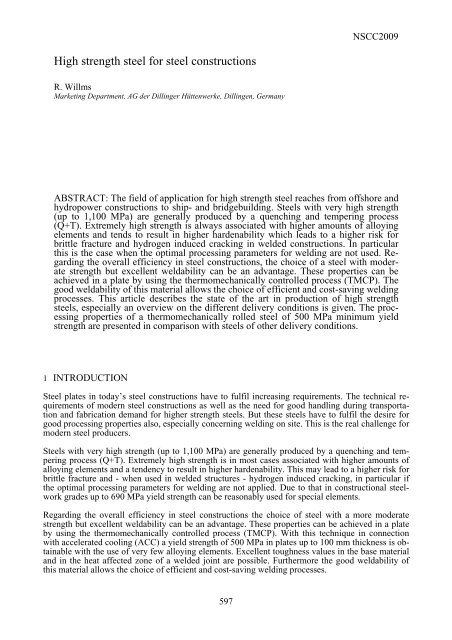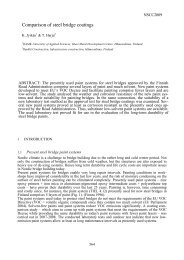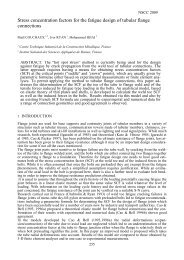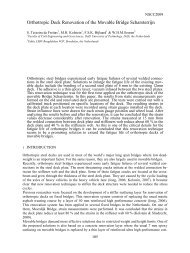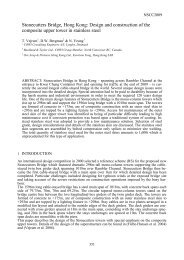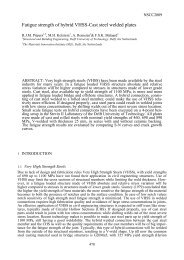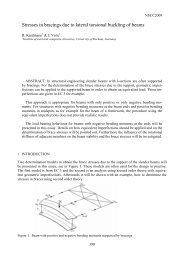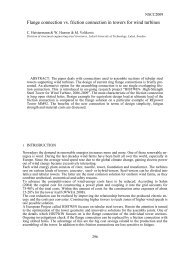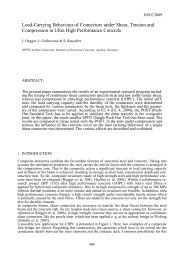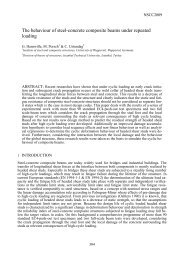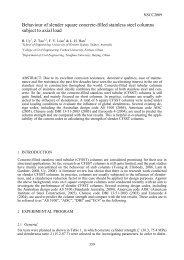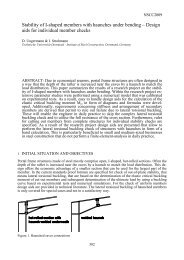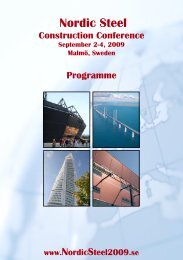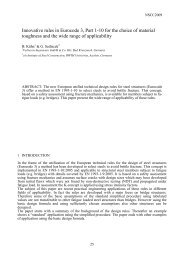High strength steel for steel constructions - Nordic Steel ...
High strength steel for steel constructions - Nordic Steel ...
High strength steel for steel constructions - Nordic Steel ...
Create successful ePaper yourself
Turn your PDF publications into a flip-book with our unique Google optimized e-Paper software.
NSCC2009<br />
<strong>High</strong> <strong>strength</strong> <strong>steel</strong> <strong>for</strong> <strong>steel</strong> <strong>constructions</strong><br />
R. Willms<br />
Marketing Department, AG der Dillinger Hüttenwerke, Dillingen, Germany<br />
ABSTRACT: The field of application <strong>for</strong> high <strong>strength</strong> <strong>steel</strong> reaches from offshore and<br />
hydropower <strong>constructions</strong> to ship- and bridgebuilding. <strong>Steel</strong>s with very high <strong>strength</strong><br />
(up to 1,100 MPa) are generally produced by a quenching and tempering process<br />
(Q+T). Extremely high <strong>strength</strong> is always associated with higher amounts of alloying<br />
elements and tends to result in higher hardenability which leads to a higher risk <strong>for</strong><br />
brittle fracture and hydrogen induced cracking in welded <strong>constructions</strong>. In particular<br />
this is the case when the optimal processing parameters <strong>for</strong> welding are not used. Regarding<br />
the overall efficiency in <strong>steel</strong> <strong>constructions</strong>, the choice of a <strong>steel</strong> with moderate<br />
<strong>strength</strong> but excellent weldability can be an advantage. These properties can be<br />
achieved in a plate by using the thermomechanically controlled process (TMCP). The<br />
good weldability of this material allows the choice of efficient and cost-saving welding<br />
processes. This article describes the state of the art in production of high <strong>strength</strong><br />
<strong>steel</strong>s, especially an overview on the different delivery conditions is given. The processing<br />
properties of a thermomechanically rolled <strong>steel</strong> of 500 MPa minimum yield<br />
<strong>strength</strong> are presented in comparison with <strong>steel</strong>s of other delivery conditions.<br />
1 INTRODUCTION<br />
<strong>Steel</strong> plates in today’s <strong>steel</strong> <strong>constructions</strong> have to fulfil increasing requirements. The technical requirements<br />
of modern <strong>steel</strong> <strong>constructions</strong> as well as the need <strong>for</strong> good handling during transportation<br />
and fabrication demand <strong>for</strong> higher <strong>strength</strong> <strong>steel</strong>s. But these <strong>steel</strong>s have to fulfil the desire <strong>for</strong><br />
good processing properties also, especially concerning welding on site. This is the real challenge <strong>for</strong><br />
modern <strong>steel</strong> producers.<br />
<strong>Steel</strong>s with very high <strong>strength</strong> (up to 1,100 MPa) are generally produced by a quenching and tempering<br />
process (Q+T). Extremely high <strong>strength</strong> is in most cases associated with higher amounts of<br />
alloying elements and a tendency to result in higher hardenability. This may lead to a higher risk <strong>for</strong><br />
brittle fracture and - when used in welded structures - hydrogen induced cracking, in particular if<br />
the optimal processing parameters <strong>for</strong> welding are not applied. Due to that in constructional <strong>steel</strong>work<br />
grades up to 690 MPa yield <strong>strength</strong> can be reasonably used <strong>for</strong> special elements.<br />
Regarding the overall efficiency in <strong>steel</strong> <strong>constructions</strong> the choice of <strong>steel</strong> with a more moderate<br />
<strong>strength</strong> but excellent weldability can be an advantage. These properties can be achieved in a plate<br />
by using the thermomechanically controlled process (TMCP). With this technique in connection<br />
with accelerated cooling (ACC) a yield <strong>strength</strong> of 500 MPa in plates up to 100 mm thickness is obtainable<br />
with the use of very few alloying elements. Excellent toughness values in the base material<br />
and in the heat affected zone of a welded joint are possible. Furthermore the good weldability of<br />
this material allows the choice of efficient and cost-saving welding processes.<br />
597
This article tries to point out the basics in heavyplate production, especially the meaning of the different<br />
delivery conditions. On this footing, the processing properties of a TMCP-<strong>steel</strong> of 500 MPa<br />
minimum yield <strong>strength</strong> are outlined in comparison with a normalised and a quenched and tempered<br />
<strong>steel</strong>. The direct effect of the delivery condition on the processing properties gives the reader a<br />
clearer sight on this topic and helps to simplify the process of choosing the right <strong>steel</strong> <strong>for</strong> a specific<br />
application.<br />
2 CHRONOLOGY AND PRODUCTION PROCESS<br />
The evolution in <strong>steel</strong> production in the heavyplate sector over the last decades is determined on the<br />
one hand by the development of quenched and tempered <strong>steel</strong>s with very high yield <strong>strength</strong>s<br />
(S690Q, S890Q, S960Q and S1100Q) and on the other hand by thermomechanically rolled <strong>steel</strong>s<br />
with a more moderate yield <strong>strength</strong>, but higher toughness (S355M, S460M and S500M). The chronology<br />
of structural <strong>steel</strong>s is illustrated in Figure 1.<br />
Figure 1. Chronology of structural <strong>steel</strong>s<br />
A classical <strong>steel</strong> plate is produced in several successive steps. First the <strong>steel</strong> is produced in a <strong>steel</strong><br />
mill and is casted either by a continuous or an ingot casting process to a slab. The slab is then rolled<br />
in a rolling mill with two aims:<br />
• Forming the desired dimensions<br />
• Improving the inner <strong>steel</strong> structure<br />
After rolling a heat treatment takes place in order to adapt the microstructure to get the desired mechanical<br />
properties. Nevertheless the right chemical composition is essential <strong>for</strong> the mechanical<br />
properties and has to be adjusted during the <strong>steel</strong> production process in the <strong>steel</strong> mill be<strong>for</strong>e casting.<br />
There, desired alloying elements are added to the liquid phase and the content of harmful trace elements<br />
like phosphorous, sulphur, nitrogen and oxygen is abated. By applying secondary metallurgy,<br />
ladle refinement and vacuum degassing a high cleanness must be achieved, which is the base <strong>for</strong><br />
high quality <strong>steel</strong>.<br />
3 DELIVERY CONDITIONS<br />
As already mentioned in Chapter 1 there are different delivery conditions: as rolled (AR), normalised<br />
(N), quenched and tempered (Q) and thermomechanically rolled (M). In Figure 2 the temperature-time<br />
diagrams of these conditions are given.<br />
After heating at temperatures of about 1100 °C the rolling of the slab takes place in the austenitic<br />
state, a crystal structure that is stable at high temperatures. After that the plate cools on calm air and<br />
the “as rolled” condition (AR) is achieved (Process A in Figure 2).<br />
598
Then, to get a more homogenous microstructure an additional heat treatment can be per<strong>for</strong>med. The<br />
plate is reheated just above the ferrite-austenite trans<strong>for</strong>mation temperature (about 800 – 900 °C,<br />
depending on the carbon content) and is cooled on calm air again. By this treatment the <strong>steel</strong> trans<strong>for</strong>ms<br />
from ferrite and pearlite to austenite and back again. This leads to a refined microstructure of<br />
ferrite and pearlite, which is called the normalised condition (N). By normalising <strong>steel</strong> grades with<br />
moderate <strong>strength</strong> and toughness requirements up to S460N can be produced (Process A + B in<br />
Figure 2).<br />
Figure 2. Delivery Conditions<br />
The temperature-time-diagram <strong>for</strong> the quenching and tempering process is quite similar to the one<br />
<strong>for</strong> normalising (Process A + C in Figure 2). After hot rolling and cooling the plate is reheated<br />
above the trans<strong>for</strong>mation temperature, so that carbon can dissolve in austenite, but then cooling is<br />
not per<strong>for</strong>med on calm air, but in water (quenching) or in another medium that cools fast enough, so<br />
that there is no time <strong>for</strong> the <strong>for</strong>mation of ferrite and pearlite which needs a diffusion process. The<br />
carbon stays dissolved and at room temperature the microstructure mainly consists of martensite, a<br />
distorted structure that has a high <strong>strength</strong> but a low toughness. With an additional tempering process<br />
the crystal latter has the possibility to relax with the effect that <strong>strength</strong> decreases while toughness<br />
increases, so that a material with a satisfactory combination of tensile and toughness properties<br />
can be produced. The effect of the tempering on the mechanical properties is shown in Figure 3.<br />
<strong>Steel</strong>s up to 1100 MPa yield <strong>strength</strong> and higher can be realised in quenched and tempered condition<br />
(Q + T).<br />
Figure 3. Influence of increasing tempering temperatures on the tensile properties (left) and on the Charpy V<br />
transition temperature (right) - S890QL, 60 mm<br />
599
Another way to get <strong>steel</strong> with high <strong>strength</strong> is to create a microstructure with an extremely fine<br />
grain. The smaller the grain size is, the higher are the tensile and toughness properties. The thermomechanical<br />
rolling (TM or TMCP) is a method to realise such a fine grained microstructure by a<br />
skilled combination of rolling steps at particular temperatures and a close temperature control<br />
(Processes D to G in Figure 2). The gain in <strong>strength</strong> obtained by the grain refinement allows reducing<br />
effectively the carbon and alloying content of the TM-<strong>steel</strong> compared to normalised <strong>steel</strong> of the<br />
same grade (Figure 4). The improved weldability that results from the leaner <strong>steel</strong> composition is a<br />
major advantage of TM-plates. The applied "rolling schedule" is individually designed, depending<br />
on the chemical composition, the plate thickness and the required <strong>strength</strong> and toughness properties.<br />
Some typical TM-processes are shown in Figure 2. Especially <strong>for</strong> thick plates an accelerated cooling<br />
(ACC) after the final rolling pass is beneficial <strong>for</strong> the achievement of the most suitable microstructure<br />
as it <strong>for</strong>ces the trans<strong>for</strong>mation of the elongated austenite grains be<strong>for</strong>e recrystallisation can<br />
happen. For very thick plates and high <strong>strength</strong> <strong>steel</strong> grades a tempering process can be used after<br />
accelerated cooling.<br />
Figure 4. Attainable yield <strong>strength</strong> in dependence on the carbon equivalent CE<br />
Figure 5 shows microstructures of the different delivery conditions. It is easy to identify the typical<br />
microstructure of normalised <strong>steel</strong> which is dominated by ferrite and pearlite. A direct comparison<br />
with TMCP structures shows two main differences. First, there are less black areas, a result of the<br />
lower carbon content and second, the smaller grain size, which is smallest when ACC is per<strong>for</strong>med.<br />
A completely different appearance has the quenched and tempered <strong>steel</strong>. The martensite that is<br />
<strong>for</strong>med by displacive trans<strong>for</strong>mation shows a acicular (needle-shaped) microstructure.<br />
Figure 5. Microstructures of various delivery conditions<br />
600
4 PROCESSING<br />
The weldability of structural <strong>steel</strong>s is of major interest <strong>for</strong> fabrication. In order to apply efficient<br />
welding procedures and also to ensure a high safety of the weld even after suboptimal welding conditions<br />
on site, <strong>steel</strong>s with excellent weldability have several advantages.<br />
Figure 6. Calculated hardness in the coarse grained HAZ as a function of weld cooling time (t8/5) <strong>for</strong> some<br />
structural <strong>steel</strong>s in the as welded condition text.<br />
The temperature-time cycles during welding have a significant effect on the mechanical properties<br />
of a welded joint. Generally the cooling time from 800°C to 500°C (t8/5) is chosen to characterise<br />
the cooling conditions of an individual weld pass <strong>for</strong> the weld metal and the corresponding heat affected<br />
zone (HAZ). Increasing heat input and interpass temperature result in slower cooling and<br />
longer cooling time t8/5. With the welding parameters and the joint geometry, t8/5 can be calculated<br />
(see EN 1011). Diagrams showing the hardness in the HAZ as a function of the t8/5 time can<br />
be used to compare the trans<strong>for</strong>mation characteristics <strong>for</strong> different <strong>steel</strong>s (Figure 6). In general the<br />
typical shape of these curves can be divided into three zones:<br />
• high hardness level at short cooling times (mainly martensitic microstructure),<br />
• lower hardness at long cooling times (bainitic microstructure),<br />
• transition zone at medium cooling time (mixed martensitic / bainitic microstructure).<br />
Figure 7. Charpy-V impact energy in the HAZ of S500M after welding<br />
However, it should also be taken into account that these diagrams represent single-pass welds only,<br />
whereas the conditions in real multi-pass welds are more complex due to the trans<strong>for</strong>mation and refinement<br />
of the initial microstructure by subsequent layers. Figure 6 shows that at short t8/5-times<br />
the high-<strong>strength</strong> <strong>steel</strong> S690Q has higher hardness values in the HAZ at than a S500M. Due to that,<br />
restrictions in the welding process of S690Q are necessary. In the HAZ of S500M the hardness does<br />
601
not exceed 320 HV10, even at very short cooling times. This results in rather low crack susceptibility.<br />
As described above, the low carbon and alloying content of TM-<strong>steel</strong>s is the reason <strong>for</strong> this advantage.<br />
The tendency of grain coarsening increases with higher heat input. This leads to a higher risk of<br />
poor ductility and bad brittle fracture behaviour in the heat affected zone. To avoid this, the heat input<br />
during welding and in connection with that the t8/5-time have to be limited by a maximum<br />
value. The Charpy-V impact values obtained in various positions in the heat affected zone of a 30<br />
mm thick S500M butt-weld joint (SAW process, 3.5 kJ/mm) are shown in Figure 7. Test results in<br />
the as-welded condition are also compared with those after Post Weld Heat Treatment (580°C/4h).<br />
Figure 8. Typical working ranges <strong>for</strong> welding of structural <strong>steel</strong>s (S355J2 – 80 mm, S500M – 50 mm,<br />
S690QL – 30 mm)<br />
Although the values are quite homogeneously distributed, the specimens taken from the root (lower<br />
subsurface) and plate centre position show slightly higher impact values due to the positive tempering<br />
effect of subsequent welding passes, which causes a refining of the microstructure. It is also<br />
clear, that the values determined at the fusion line, i.e. the coarse grained zone (CGHAZ), are<br />
somewhat lower than the values in a distance of 2 mm. A PWHT has only a minor influence on the<br />
toughness. To sum up it can be said that a toughness level of 50 J at –40°C can easily be fulfilled<br />
even <strong>for</strong> welding with a high heat input of 3.5 kJ/mm. That allows the fabricator to apply high per<strong>for</strong>mance<br />
welding techniques and to reduce working time.<br />
Figure 9. Ageing behaviour of S500M<br />
Figure 8 compares applicable working ranges <strong>for</strong> welding of several structural <strong>steel</strong>s of different<br />
nominal yield <strong>strength</strong>s. The lower limit of the heat input and interpass temperature (preheating<br />
temperature) is set to avoid hydrogen induced cold cracking, the upper limit of the heat input and<br />
602
interpass temperatures is set to gain sufficient tensile and toughness properties. It is obvious that the<br />
working range <strong>for</strong> high-<strong>strength</strong> plates (S690) is restricted in order to obtain sufficient <strong>strength</strong> values<br />
in the weld. The TM <strong>steel</strong> has by far the widest working range resulting in the possibility to use<br />
highly efficient welding procedures in high safety when welding in on site conditions has to be applied.<br />
The behaviour after cold <strong>for</strong>ming is simulated by artificial straining and ageing tests. Cold <strong>for</strong>ming<br />
has an influence on the toughness of the <strong>steel</strong> and even more if the cold-<strong>for</strong>med area is heated as it<br />
occurs during welding. This is a matter of fact. Figure 9 shows Charpy-V-temperature-transition<br />
curves <strong>for</strong> S500M <strong>steel</strong> in the delivery condition as well as after 5% straining and artificial ageing at<br />
250°C. Obviously the Charpy-V transition curve shifts to higher temperatures if cold <strong>for</strong>ming is<br />
per<strong>for</strong>med and even more after a further simulated ageing treatment. Despite these hard conditions,<br />
very good toughness levels can be reached which results in good <strong>for</strong>mability.<br />
5 APPLICATION<br />
Originally TMCP-<strong>steel</strong>s of 500 MPa minimum yield <strong>strength</strong> come from the offshore industry. On<br />
offshore plat<strong>for</strong>ms high safety is of immense importance. So it is not astonishing, that TMCP-<strong>steel</strong>s<br />
are used <strong>for</strong> this kind of application. Figure 10 (left) shows the Valhall Plat<strong>for</strong>m in Norway. Here<br />
S500M was applied in a thickness up to 65 mm.<br />
Figure 10. Valhall-Plat<strong>for</strong>m (left, Photo: Aker Kvaerner Norway), pumped storage power station (right,<br />
Photo: Voith Siemens Hydro)<br />
Figure 10 (right) represents in section the typical structure of a pumped storage power station where<br />
water is stored in a upper basin. It is accelerated in conduits, so called penstocks, to use the kinetic<br />
energy to produce electricity with generators driven by turbines. The wall thickness of penstocks<br />
can amount to 60 – 80 mm or even more. The penstock is assembled of pipe sections that are produced<br />
by bending a plate around the transverse axis. These sections have to be welded together on<br />
site under severe conditions. Here thermomechanically rolled plates of the <strong>steel</strong> grade S500M are<br />
applied as an optimum compromise between a high yield <strong>strength</strong> and good processing properties.<br />
But not only the energy sector counts on the advantages of high <strong>strength</strong> TMCP-<strong>steel</strong>s. Also in constructional<br />
<strong>steel</strong>works these <strong>steel</strong>s become more and more popular.<br />
Figure 11 (left) shows the first part of the Airbus-hangar on Frankfurt Airport. With a length of 180<br />
m, respectively 170 m <strong>for</strong> the planned second part of the building that is not yet erected, and a depth<br />
of 120 m, the hangar is designed to enable the maintenance of five Airbus A380 at the same time. It<br />
was necessary to use a special girder construction to realise a span width of 180 m. For this construction<br />
tailor-made TMCP-<strong>steel</strong> was applied, a modified version of S460ML. The European standard<br />
EN 10025 specifies a reduction of the minimum guaranteed yield <strong>strength</strong> with increasing<br />
plate thickness. For this project minimum yield <strong>strength</strong> of 460 MPa was guaranteed even <strong>for</strong> 120<br />
603
mm plate thickness (EN standard only demands 385 MPa). This was possible by the use of the <strong>steel</strong><br />
design concept of a S500ML.<br />
Figure 11. Airbus-Hangar Franfurt (left, Photo: Lufthansa), WFC Shanghai (right, Photo: Mori Building)<br />
The world financial center in Shanghai (Figure 11, right) was inaugurated on August 30, 2008. Designed<br />
in the nineties and originally intended to be the tallest building in the world, it is now<br />
China´s tallest building and the third highest in the world with 492 m and 101 floors. The building<br />
features a concrete core with four mega columns at the corners, linked to one another by truss belts<br />
and to the core by bracing elements. For this very special structure amongst others S460ML was<br />
applied in thicknesses up to 100 mm. A minimum yield <strong>strength</strong> of 450 MPa was demanded and<br />
could be guaranteed instead of 400 MPa according to the European standard by the use of the same<br />
concept as above.<br />
6 CONCLUSION<br />
The paper gave an overview of the different kinds of structural <strong>steel</strong>s and their delivery conditions.<br />
The thermomechanical rolling has developed over the last years so that today plates with extraordinary<br />
toughness values and a yield <strong>strength</strong> class of a S500 in thicknesses up to 100 mm can be produced.<br />
The excellent weldability of these <strong>steel</strong>s in connection with high safety in processing, especially<br />
in on site conditions, makes TM-<strong>steel</strong> more and more essential in <strong>steel</strong> <strong>constructions</strong>.<br />
7 REFERENCES<br />
[1] R. Willms, F. Schröter - Hochfeste Stahlbleche, Hochleistungswerkstoffe im konstruktiven<br />
Stahlbau, VDI-Berichte Nr. 1970 Bauen mit innovativen Werkstoffen, 2007, Leonberg, P. 301<br />
[2] F. Hanus, F. Schröter, W. Schütz - State of the art in the production and use of high-<strong>strength</strong><br />
heavy plates <strong>for</strong> hydropower applications, Proceedings of the conference on <strong>High</strong> Strength <strong>Steel</strong> <strong>for</strong><br />
Hydropower Plants, July 2005, Graz, 13-01<br />
[3] F. Schröter, R. Valentin, J. Schütz - Production and Application of modern thermomechanically<br />
rolled high-<strong>strength</strong> heavy plates <strong>for</strong> hydropower applications, Proceedings of the 14th Intern.<br />
Seminar on Hydropower Plants, 2006, Vienna<br />
[4] F. Martin, F. Schröter - Structural <strong>steel</strong> <strong>for</strong> the application in offshore, wind and hydro energy<br />
production: Comparison of application and welding properties of frequently used materials, Proceedings<br />
of the International Conference on Safety and Reliability of Welded Components in Energy<br />
and Processing Industry, IIW, 2008, Graz<br />
[5] R. Willms - <strong>High</strong> <strong>strength</strong> <strong>steel</strong>s in <strong>steel</strong> construction: Application and processing, Proceedings<br />
of the 5th European Conference on <strong>Steel</strong> and Composite Structures, EUROSTEEL 2008, Graz, P.<br />
1083<br />
604


